Carbohydrates and Diabetes: What You Should Know.
By Kat Brown, Recent ASU Nutrition Student
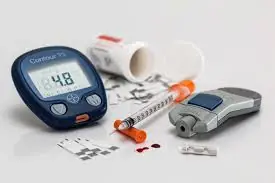
What are carbohydrates?
Carbohydrates are a macronutrient that provides fuel for the body. They are broken down into glucose in the body and are a big part in controlling your body’s blood glucose levels. The main types of carbohydrates are sugar, starches, and fiber. These can also be classified as simple or complex carbohydrates. When counting carbohydrates in the diet all three types should be considered. 3 The different types of carbohydrates may affect your blood sugar differently so it is important to work with your dietitian to learn what carbohydrates are best for your diet.
What types of carbs should you be consuming?
The recommended types of carbohydrates for consumption include whole grains, vegetables, fruits, and legumes.1 Nuts can be a great snack and vegetables with edible skin or seeds are also great choices. When choosing pasta, breads, and cereals look for whole grain or whole wheat options. Foods with naturally occurring sugar like milk are better options than foods with extra sugar added such as juices and soda. The guidelines for the general public should be followed for individuals with diabetes.
- Whole Grains: Half of all grains consumed should be whole grains.
- Fiber: Daily recommendation for women is 25g and for men 38g.
How do carbohydrates affect your diabetes?
The America Diabetes Association cites that in 2012 29.1 million Americans were suffering from diabetes and that diabetes is the 7th leading cause of death in the United States. The CDC states that eating healthy is one of the top ways to prevent and manage diabetes. Glycemic control is a crucial part of controlling and managing diabetes. Carbohydrates are ranked according to how they affect your blood glucose levels. 2 A carbohydrate with a low GI will not cause blood glucose values to rise as quickly as a food with a high GI value. 2
Important labs for monitoring your diabetes.
- Glycated hemoglobin (A1C) test2
Goal: <7%
- Random blood sugar test
Normal values < 200mg/dL
- Fasting blood sugar test
Normal values 70-100 mg/dL
- Oral glucose tolerance test
Normal values
- LDL <100mg/dL2
- TG < 150mg/dL2
- HDL >40mg/dL for men; > 50mg/dL for women2
- An eye exam may be necessary to check for blood vessel function
- Foot exam to check for proper nerve function
Making Good Choices:
- Consider portion sizes.1 Make sure that you are reading labels and eating appropriate serving sizes. Refer to the diabetic exchange for accounting for each serving size.
- Choose whole grains that will provide fiber. Choose whole grains that will provide fiber. A whole grain food will contain the grain seed, germ, bran, and endosperm.3
- Avoid sugary beverages which can quickly elevate blood glucose levels.
- Incorporate at 30 minutes of moderate physical activity into a daily routine.5 This has been found to help lower insulin requirements, improve insulin sensitivity, and improve glucose tolerance. 5
Talk to your Dietitian
Each person’s needs are different so it is best to consult with your dietitian to develop a personalized diet plan to manage your diabetes.4 Medical Nutrition Therapy can be used to help treat your diabetes and develop the best well-rounded diet plan to maintain your blood glucose levels. Talk to you RD about carbohydrate counting and exchange.
References
- Marcason, W. (2014). What is the role of carbohydrates in the management of diabetes? Journal of the Academy of Nutrition and Dietetics, 114(10), 1696.
- Saul, N. (2010). Using the glycemic index in diabetes management. The American Journal of Nursing, 110(7), 68; 68-69; 69.
- Evert, A., Boucher, J., Cypress, M., Dunbar, S., Franz, M., Mayer-Davis, E., et al. (2013). Nutrition therapy recommendations for the management of adults with diabetes.36(11), 3821 – 3842.
- Wylie-Rosett, J. (2012). Medical nutrition therapy for youth with type 1 diabetes mellitus: More then carbohydrate counting. Journal of the Academy of Nutrition and Dietetics, 112(11), 1724; 1724-1727; 1727.
- Hayes, C. (2008). Diabetes and exercise. AADE Position Statement, 34(1), 37-40.
Filling your Plate with Peas!
By Sarah LeVesque, Recent ASU Nutrition Student,
Eat your peas! No, really! They’ve got fiber, antioxidants, and are packed with nutrients. You can find them in your fried rice, in baby food all mashed up, and as a side dish at dinner. Frozen, canned, or as a split pea soup, it’s a popular vegetable legume. You heard it! It’s not technically a vegetable. They belong to the legume family. Like lentils, chickpeas, beans, and peanuts, green beans are the seeds of a legume plant. But people commonly know them as veggies, so we don’t have to burst their bubbles, we can still call them vegetables!

Peas can be purple, black-eyed, yellow, or green. We’re going to talk about green peas which are nutritious and high in complex carbohydrates. You can tell they’re starchy from their consistency. Just ½ a cup of green peas is only 62 calories! Of those calories, 72% comes from carbohydrates, 23% from proteins and 3% from fats. High in fiber and protein, rich in nutrients, and rich in antioxidants, green peas will earn a spot on your plate!
Vitamins
Green beans are vitamin rich! For 62 calories, they contain 34% of the daily recommended intake of vitamin A. That’s a lot for half a cup of green peas! Vitamin A is involved in many functions in our body including the maintenance of our heart, lungs, kidney and other organs. Vitamin A is involved in immune functions, vision, reproduction, and cellular communications.
Vitamin K is another prominent nutrient that we can get from green peas. Coming in at 24% of the recommended daily intake of vitamin K, green peas are a great way to get your serving of an important fat-soluble vitamin. Vitamin K helps blood clotting and coagulation and is important in bone health. It also has been studied for its anticancer abilities!
Here’s a vitamin that we rarely think of when we look at peas: Vitamin C. Green peas offer 13% of our recommended daily intake. Vitamin C is important because it helps to produce and maintain collagen which is found in our skin, ligaments, tendons, cartilage, bones, blood vessels, intestines, the eye, and in our muscle tissue! Collagen has been studied for its ability to protect our skin, stop aging, and help our wounds heal. Vitamin C also helps produce carnitine, neurotransmitters, calcium in our bones, and is supports our immune systems.
Green peas also contain 15% of our recommended intake of thiamine! This vitamin helps our bodies convert our food to fuel. Folate is also found in green peas! They offer 12% of our recommended daily intake. Folate is important for many things but is vital in brain function. It’s also important during pregnancy as it helps produce genetic material.
We can also find riboflavin, niacin, and vitamin B6 in green peas, but in smaller amounts.
Fiber & Protein
Green peas have a good amount of fiber and protein in them: 4 grams of each in just half a cup. Fiber and protein found in green peas help to slow down digestion and controls the breakdown of starches keeping our blood sugar levels steady. This leaves us feeling fuller, longer. Which can save us calories in the long run. If you’re into meal prepping, adding a starchy vegetable into your diet can help curb your appetite and cravings!
Fiber also keeps your gut healthy! It prevents unhealthy bacteria from getting out of control and feeds the good bacteria’s we have in our intestines. Getting enough fiber in our diets can help prevent gastrointestinal conditions and even colon cancer. Diets high in fiber have produced lower cholesterol levels, especially “bad” LDL cholesterol.
Other health benefits
Green peas have been studied for their ability to help prevent chronic diseases. Because green peas are high in minerals like magnesium, potassium, and calcium, research has shown that these nutrients are helpful in controlling blood pressure. Green peas also contain flavanols, carotenoids, vitamin C. These antioxidants fight to reduce cell damage, which can also reduce the risk of cancer.
If you’re going to eat green peas, you won’t need to plug your nose for too long if you eat just a half of a cup. Filling your plate with green peas could rival your daily multivitamin when paired with other nutritious foods. You can find green peas in the grocery stores fresh, frozen, or canned, but I hear fresh garden peas are the way to go!
For unique recipes for peas check out the Fill Your Plate recipe section! However, if peas are not for you, there are hundreds of other recipes to choose from.
Do You Have “Mushroom” in Your Life for Mushrooms?
By Jessica Bombace, Recent ASU Nutrition Student
The mushroom is not just a fungus, a toad’s stool or found in fairytales, it is more beneficial than we think.
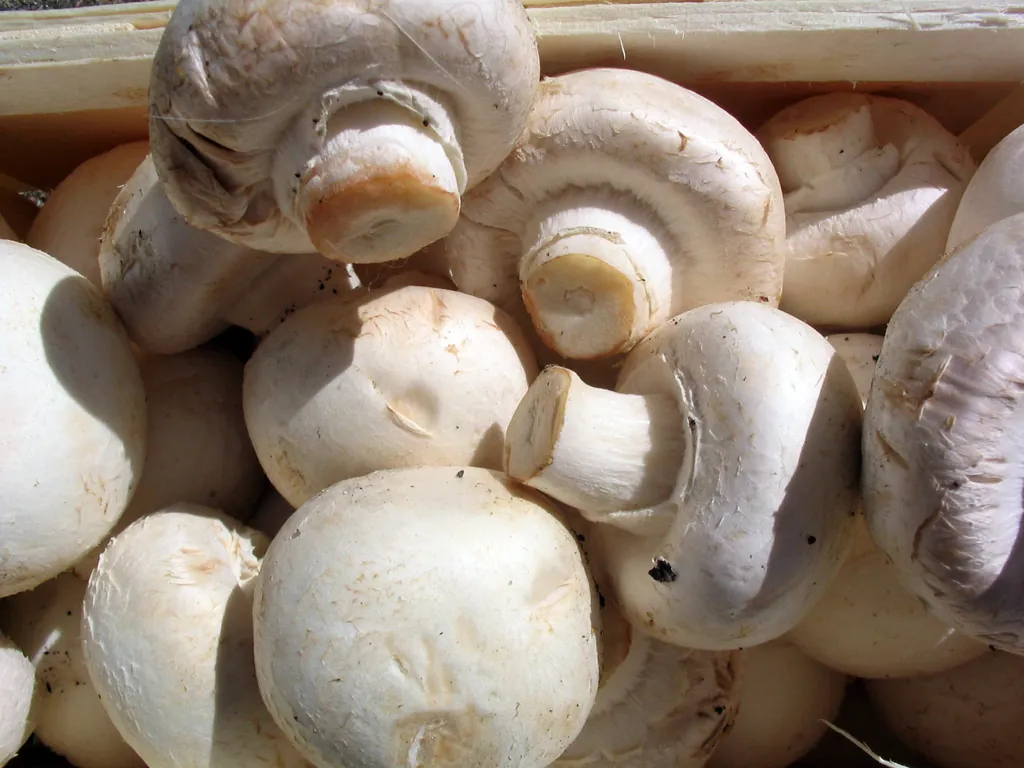
So, what exactly is a mushroom? Is it a plant? Is it a fruit? A major misconception is that the mushroom is a plant. According to a documentary “The Magic of
Mushrooms”, mushrooms are not plants but they are actually more of an organism of their own (2). They seem to be more related to animals than produce (3). Mushrooms are fungi, which a lot of people are aware of. They do not contain chlorophyll, which is found in plants and are most of them are considered to be saprophytes (3). Saprophytes are an organism in which they obtain their nutrients from dead matter like dead or decaying plant and animal matter (4).
There are so many different species of mushroom-forming fungi in the world, an estimate of 140,000 species to be exact (4). Out of 140,000 species, only about 100 of those are actually being closely observed and studied for their health benefits and ways to apply them to the medical world (4). Imagine all the potential possibilities and breakthroughs that could happen in the future if more than 100 of them are studied!
Health of Mushrooms
According to Steingold in State College, Pa, there is a new study that has developed that the high concentrations of the antioxidants found in mushrooms also has anti-aging benefits (5). Researchers at Penn State did a study by taking different mushrooms and evaluated them and came to a finding that it contains high levels of ergothioneine and glutathione, which are significant antioxidants (5). The “free radical theory”, which is when our food oxidizes food free radicals form and can be toxic (5). After a great number of free radicals form and are available, they may lead to illnesses such as cancer (5).
Here are 11 interesting health benefits of mushrooms proved by organicfacts.net (4)
- Lower Cholesterol: Mushrooms contain no cholesterol at all and also contains fiber and certain enzymes in them help to lower a person’s cholesterol. Therefore the prevention and risk of developing cardiovascular diseases are also lowered. Two for the price of one!
- Treat Anemia: Having anemia is having low levels of iron in your blood. Mushrooms are a great source of iron as well as having over 90% of the nutritive iron value will be absorbed through the blood.
- Prevent Cancer: Amazingly mushrooms contain two substances called beta-glucans and conjugated linoleic acid, which have anti-carcinogenic effects. Mushrooms are very effective in preventing both breast and prostate cancer because of the substances mentioned before.
- Prevent Disease: Since mushrooms have no cholesterol, no fats, high protein content, low amounts of carbohydrate and an abundance of vitamins and minerals, it is a great source of food for someone who is diabetic. Furthermore, they also have natural insulin and enzymes that break down sugar/starch in food.
- Improve Bone Health: Another great nutrient that mushrooms contain is a rich amount of calcium. Calcium helps not only strengthen bones but also forms them.
- Help in Nutrient Absorption: Unlike plants that do not contain vitamin D, mushrooms, on the other hand, have an edible form of vitamin D and it is actually the essential vitamin that helps in the absorption of nutrients.
- Boost Immune System: An antioxidant, ergothioneine, is a powerful antioxidant that is found in mushrooms. It’s has a very powerful effect on protecting from free radicals and boosting the immune system.
- Lower Blood Pressure: There are some mushrooms like shiitake and maitake mushrooms that contain a high amount of potassium. Potassium itself relaxes the tension in the blood vessels which therefore lower blood pressure altogether.
- Increase Iron Absorption: Copper, another mineral found in mushroom helps regulate and stimulate the absorption of iron that is consumed through food.
- Rich in Selenium: Selenium is a nutrient that is not really focused on is actually a very beneficial mineral to us. Not only does selenium act as an antioxidant it also helps strengthen & increase durability in bones, and strengthen teeth, hair, and nails.
- Weight Loss: Lean protein foods are known to help with weight loss
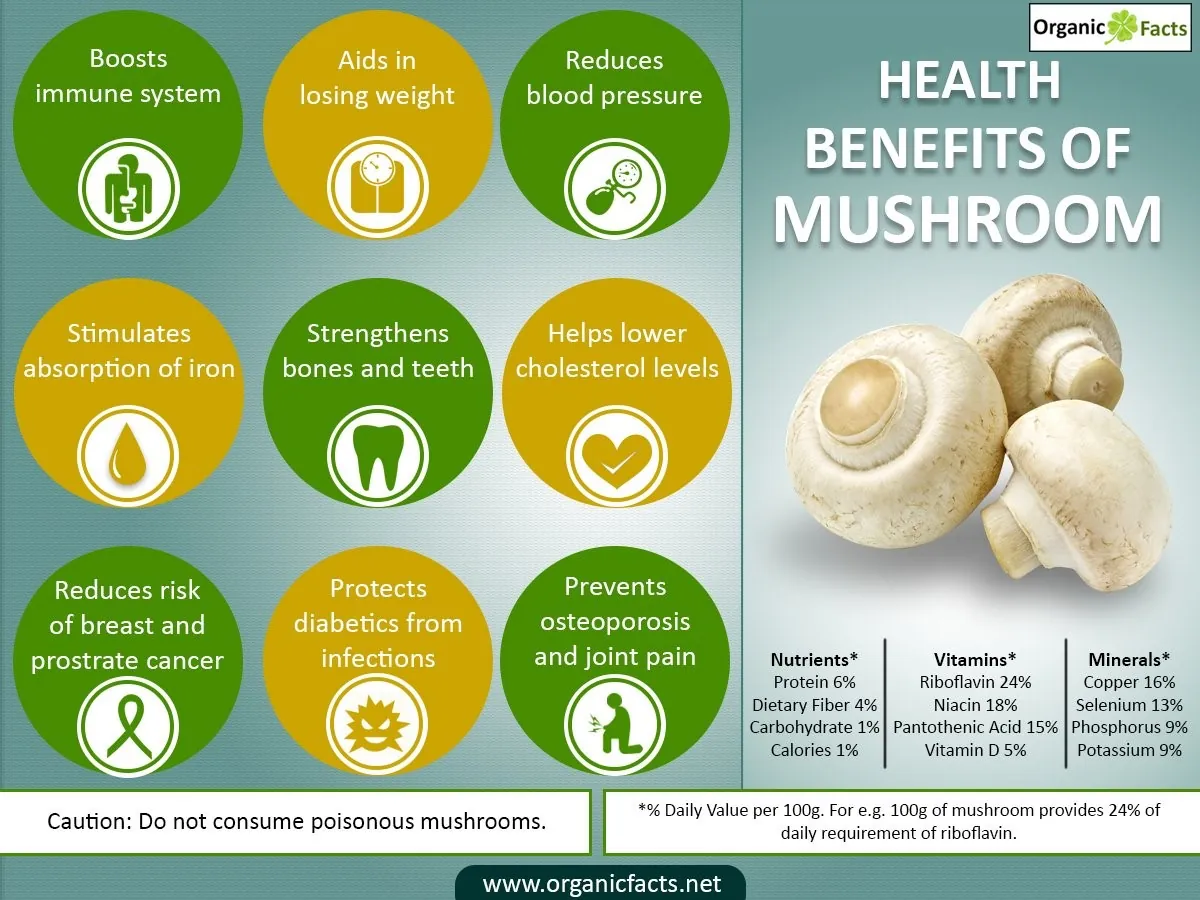
(4)
New Uses of Mushrooms
Mushrooms are such versatile organisms that it is becoming so popular outside of the world of nutrition. An alternative to plastic packaging is here and its mushrooms! That’s right mushrooms are being converted into an environmentally friendly packing material. What is so great about this finding is that unlike plastic, mushrooms are biodegradable and will be able to be recycled or broken down to matter. In the documentary “Magic of Mushrooms,” they showed how a company in New York is turning mushrooms into packaging (2). Below is a picture of a corner that would be used to protect parts while being shipped.

(6)
Mushroom Farms in Arizona!
If you are ever interested in checking out mushroom farms in Arizona here is a list of mushroom farms:
- Old Pueblo Mushroom Growers, Dudleyville, Arizona
- Sonoran Mushroom Company, Tuscan, Arizona
- Sun Valley Harvest, Glendale, Arizona
- Symbiotic Farms, Scottsdale, Arizona
Check out Fill Your Plate for fun recipes that will bring mushrooms to your dinner table in an exciting way. If you are wanting to buy fresh mushrooms from your local Farmer’s Market, Fill Your Plate will help you locate one near you.
References
(1) Retrieved from https://www.google.com/search?q=beautiful+mushrooms&rlz=1C5CHFA_enUS703US704&tbm=isch&source=iu&pf=m&ictx=1&fir=kOKK4ReHwRfNkM%253A%252CCZyxw_6AEYFWXM%252C_&usg=__QSnlkAJNKyHYJdOUg9QR14mohFk%3D&sa=X&ved=0ahUKEwi5gIWhxsvXAhWG5SYKHZPeBngQ9QEINDAF#imgrc=kOKK4ReHwRfNkM:
(2) Lehmann, A. (Director). (2014). Magic of mushrooms [Motion picture]. United Kingdom.
(3) Retrieved from http://www.gmushrooms.com/info.htm
(4) Retrieved from http://www.gmushrooms.com/info.htm
(5) Study Finds Mushrooms May Have ‘Fountain Of Youth’ Benefits. (2017, November 13). Retrieved from https://www.studyfinds.org/mushrooms-anti-aging-antioxidants/
(6) Retrieved from https://www.google.com/search?q=mushrooms+as+packaging+material&rlz=1C5CHFA_enUS703US704&source=lnms&tbm=isch&sa=X&ved=0ahUKEwixo-DR68vXAhUKOiYKHaFLCacQ_AUICigB&biw=874&bih=618#imgrc=mtI7epKCHIYurM:
My 1 Week Ketogenic Meal Plan
By recent ASU nutrition student Alysia Nelson
Part of an ongoing series of articles on the Ketogenic Diet
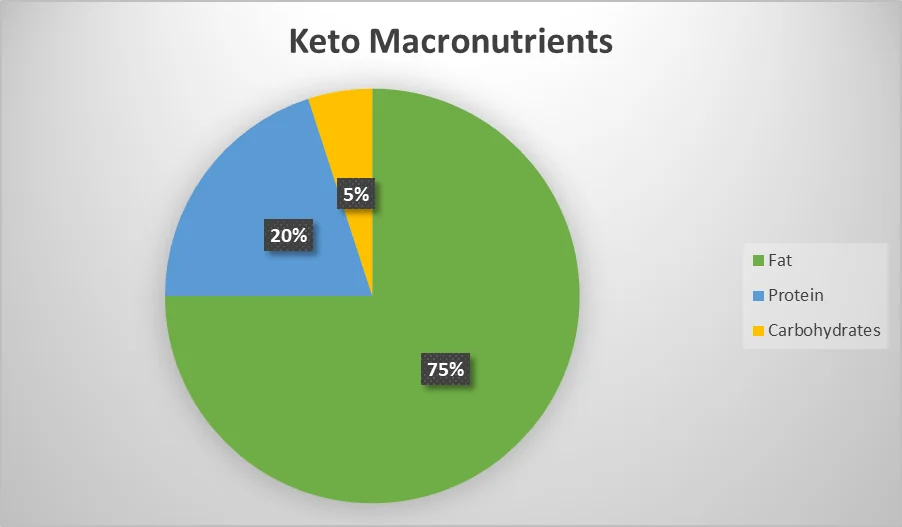
As a Nutrition Student at Arizona State University, I recognize how important a diet is for overall health and wellness. I typically eat a well-balanced diet including organic grass-fed meats, whole grains, low-fat dairy products, fruits, vegetables, nuts, and seeds. I also live a very active lifestyle working, running around with my two dogs, and exercising at least 4-6 times per week. On my previous 1,300 calorie/day meal plan, there was something that I always felt was lacking. Now I know the difference between hunger and appetite, and I knew that I wasn’t satisfied with my food and still felt like I wanted to keep eating. This put me in a vicious cycle of guilt anytime I consumed anything that wasn’t “healthy” even when it was the occasional treat. Upon many hours of research on the ketogenic diet, I decided to try it to share my personal experience with you. Here is what I decided on, a meal plan that was perfect for me. This is the start to my keto journey.
Starting BMI: Normal (20.7)
Starting Weight: 145
Calories/ day: 1,490
Activity Level: Active (gym 5-6 days per week)
Macronutrient Goals: Net Carbohydrates (19g or 5%), Protein (75g or 20%), Fat (124g or 75%)
Beverages consumed during the week duration: At least 1 gallon of water per day.
MONDAY:
| Breakfast | · 2 cage-free eggs cooked · .5 medium avocado · 2 slices uncured bacon · 1 tsp ground flaxseed · Salt & pepper to taste
495 calories |
| Snack | · Whole milk String-cheese · 4 slices uncured salami · .5oz macadamia nuts 302 calories |
| Lunch | · 1 cup romaine lettuce · 1 cup spinach · .5 tbsp block shredded feta cheese · 1tbsp sliced almonds · 1 tbsp oil & vinegar 166 calories |
| Dinner | · 1 chicken thigh with skin · .5cup keto cauliflower mash · 1tbsp sweet cream butter · Salt & pepper to taste 488 calories |
Total Calories: 1452 of 1490 goal
Macronutrient Content:
Fat: 122g (77% of 75% goal)
Protein: 63g (18% of 20% goal)
Carbohydrates: 20g (5% of 5% goal)
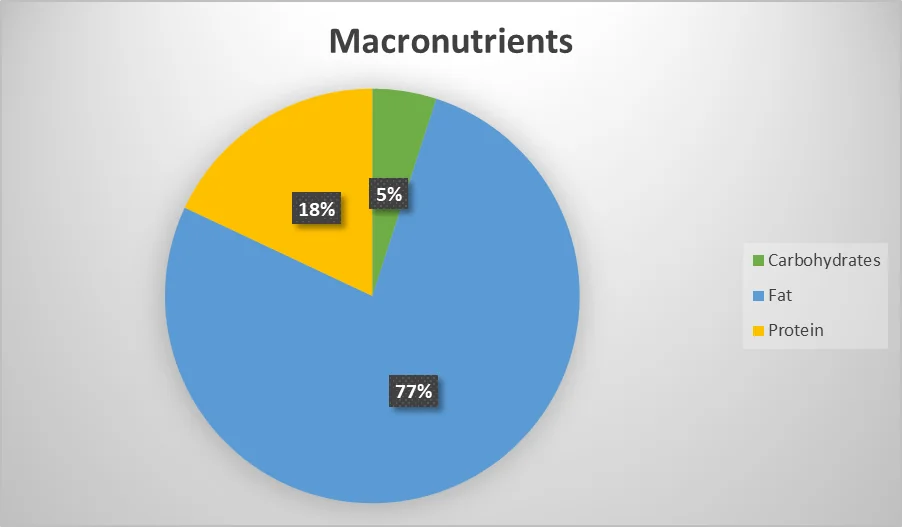
TUESDAY:
| Breakfast | · 2 eggs cooked · .5tbsp unsalted butter · 2 slices uncured bacon · .5 med avocado 413 calories |
| Snack | · 1 oz homemade keto granola · 1 Whole milk string cheese 203 calories |
| Lunch | · 2 servings homemade Keto fathead pepperoni pizza 412 calories |
| Dinner | · 4 oz ribeye · 1 cup kale · 1 tbsp sliced almonds · .5 tbsp virgin olive oil 454 calories |
Total Calories: 1482 of 1490 goal
Macronutrient Content:
Fat: 155g (76% of 75% goal)
Protein: 83g (18% of 20% goal)
Carbohydrates: 25g (6% of 5% goal)
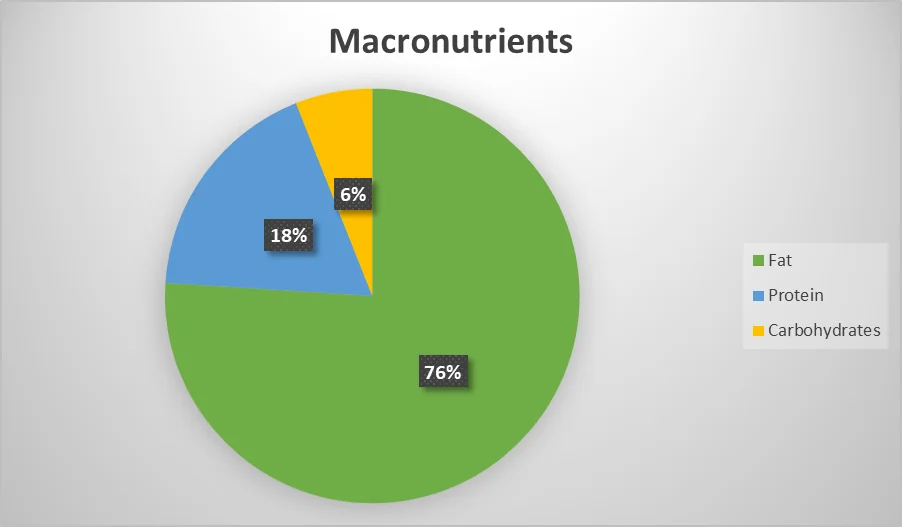
WEDNESDAY:
| Breakfast | · Keto omelet (eggs, spinach, feta cheese, tomatoes, flaxseeds, green bell pepper) · 2 tbsp unsalted butter · Salt & pepper to taste 434 calories |
| Snacks | None eaten |
| Lunch | · 4 Keto Meatballs · 1 oz salted macadamia nuts · .5oz cream cheese 681 calories |
| Dinner | · 1 boneless chicken breast · 2tbsp block shredded cheddar cheese · 1tbsp sour cream · .5 medium avocado · Salt & pepper to taste 338 calories |
Total Calories: 1453 of 1490 goal
Macronutrient Content:
Fat: 111g (70% of 75% goal)
Protein: 85g (23% of 20% goal)
Carbohydrates: 13g (5% of 5% goal)
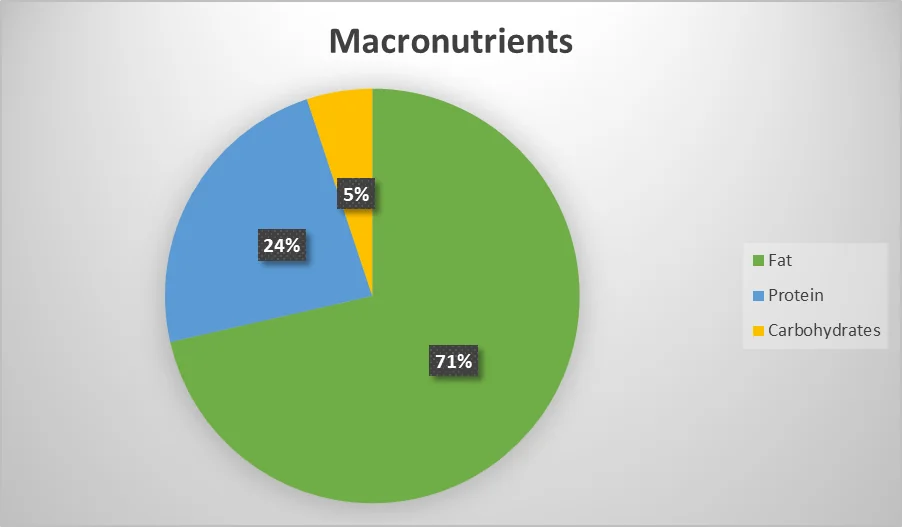
THURSDAY:
| Breakfast | · 3 homemade keto cream cheese pancakes 320 calories |
| Snack | None eaten |
| Lunch | · 4 slices uncured salami · 8 slices uncured pepperoni · 1 oz block cheddar cheese · 1tbsp pumpkin seeds · 1 tbsp sliced almonds 382 calories |
| Dinner | · 1 chicken thigh · 1.5 tbsp salted butter · 1 cup steamed broccoli · 2 homemade keto rolls |
Total Calories: 1442 of 1490 goal
Macronutrient Content:
Fat: 119g (77% of 75% goal)
Protein: 64g (19% of 20% goal)
Carbohydrates: 15g (4% of 5% goal)
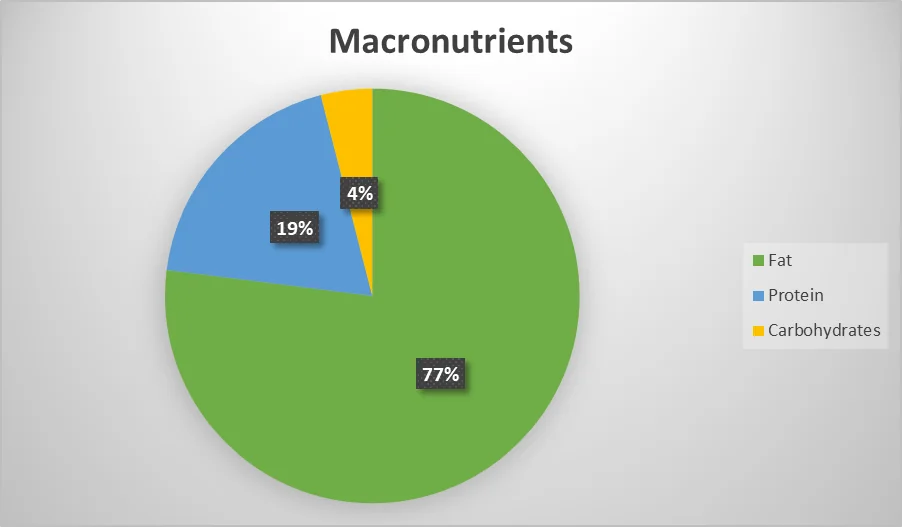
FRIDAY:
| Breakfast | · 3 cage-free hard-boiled eggs · Salt & pepper to taste · 1 oz arugula · 1 tbsp coconut oil · 2 slices uncured bacon 581 calories |
| Snack | · 1 oz almonds · 1 whole milk string cheese 265 calories |
| Lunch | Not eaten |
| Dinner | · Homemade “protein style” burger (beef, sliced cheddar cheese, lettuce) · Homemade “spread” 520 calories |
Total Calories: 1366 of 1490 goal
Macronutrient Content:
Fat: 113g (74% of 75% goal)
Protein: 69g (20% of 20% goal)
Carbohydrates: 20g (6% of 5% goal)
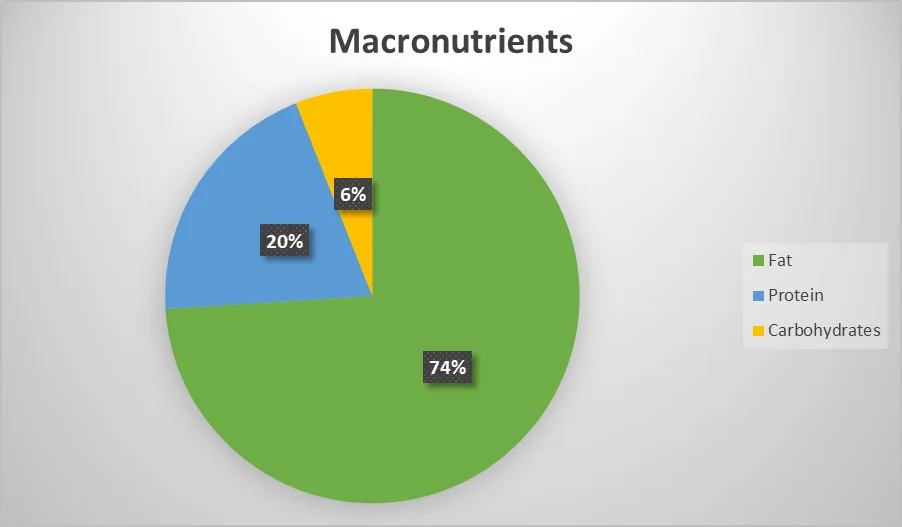
SATURDAY:
| Breakfast | · Keto eggs benedict (2 cage-free eggs, homemade hollandaise sauce) · 2 slices uncured bacon · .5 med avocado 694 calories |
| Snack | None Eaten |
| Lunch | · 2 slices keto cloud bread · 2 oz natural slow roasted turkey breast · 1 cup spinach · 1tbsp homemade keto pesto · 1 slice pepper jack · 30g sunflower seeds 486 calories |
| Dinner | · 4oz, grain-free, boneless chicken breast · 1 cup steamed cauliflower “rice” · .2c homemade keto garlic sauce |
Total Calories: 1443 of 1490 goal
Macronutrient Content:
Fat: 116g (71% of 75% goal)
Protein: 80g (22% of 20% goal)
Carbohydrates: 24g (7% of 5% goal)
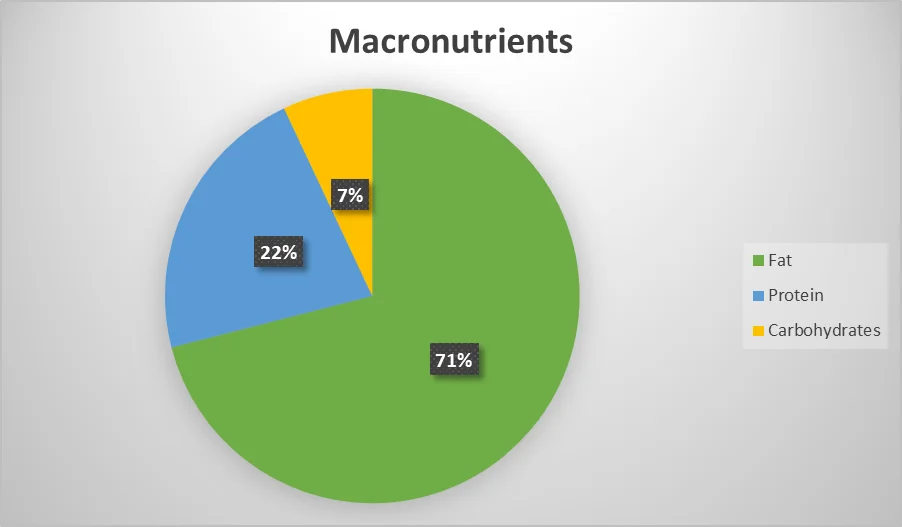
SUNDAY:
| Breakfast | · 2 cage-free eggs · .5 medium avocado · 1tbsp salted butter
357 calories |
| Snack | None eaten |
| Lunch | · Homemade keto “grilled cheese” 803 calories |
| Dinner | · 4 oz ground turkey · 1 cup spring mix · 1tbsp olive oil & vinegar · 1tbsp sliced almonds · .5tbsp salted butter 291 calories |
Total Calories: 1451 of 1490 goal
Macronutrient Content:
Fat: 120g (74% of 75% goal)
Protein: 64g (18% of 20% goal)
Carbohydrates: 29g (8% of 5% goal)
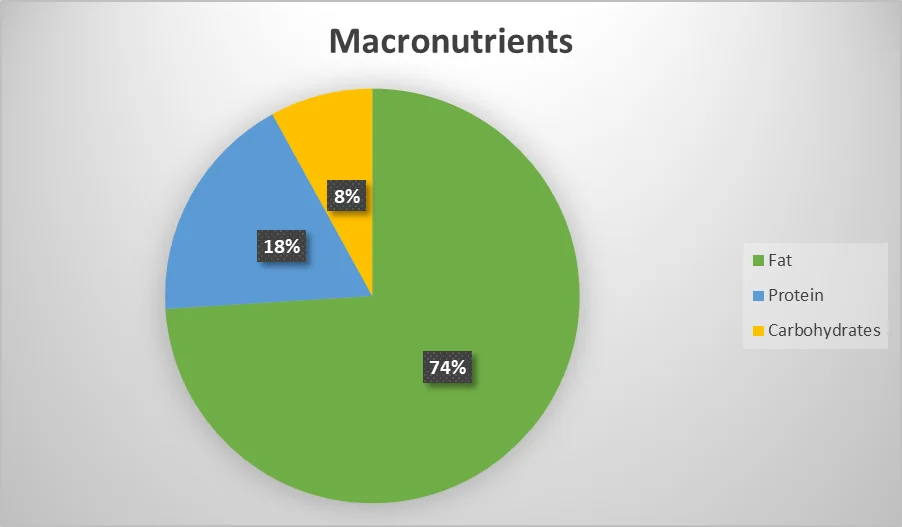
RESULTS
After 1 week of following a ketogenic diet, combined with working out, I felt a significant change in energy and mood. I experienced all the symptoms of the “keto flu” and initiated supplementation of magnesium, potassium, and omega-3 fatty acids. After balancing my electrolytes, I felt better than I ever had! I also noticed a 10-pound weight loss, however, I noted this to be water weight. I was able to get into ketosis after the first 3 days and had moderate present ketones using urine ketone testing strips. Please note that all results for carbohydrates were total carbohydrates and not net carbohydrates (total carbs-fiber). I calculated these separately and never once went above 20g of net carbs creating an optimal ketosis response. I also felt fuller and satisfied on this diet than I have previously felt following a balanced diet.
CONCLUSION
While a ketogenic diet can be great for weight loss, it’s a diet that must be researched and understood properly. I suggest anyone wanting to try this diet to consult with their doctor prior and utilize tools, such as myfitness app, to help track macronutrients and micronutrients. For ketogenic recipes, checkout Ketokitchen.
Editor’s Note: Fill Your Plate neither endorses or supports this type of diet, but encourages readers to always consult with your doctor regarding special diets. This series shares one nutrition student’s experiences with the diet.
Ketogenic Diet: A Treatment for Alzheimer’s Disease
By recent ASU nutrition student Alysia Nelson
Part of an ongoing series of articles on the Ketogenic Diet
Alzheimer’s Disease is the 6th leading cause of death in the United States killing more than breast cancer and prostate cancer combined.1 Total deaths from this disease have increased 123% within the last 18 years costing the nation $277 billion.1 Currently, 5.7 million Americans have Alzheimer’s and by 2050 it is estimated that 14 million people will live with this disease.1 Even though Alzheimer’s is in the forefront of medical research, there is still so much about the disease that isn’t clear. Since Alzheimer’s Disease is the most common form of dementia, millions of people are living with an incurable disease.1 Imagine, if we could stop the progression of this disease through nutrition, the millions of lives that would be affected. There may be hope for a new treatment, and it begins with a Ketogenic Diet.

What do we know about Alzheimer’s? Alzheimer’s is a form of dementia, affecting memory, thinking, and behavior.1 It is a progressive disease which means that it worsens over time.1 Although most Seniors over the age of 65 are affected by this disease, it is still not a normal part of aging. Early-onset Alzheimer’s affects 200,000 Americans under the age of 65.1 Looking at the brain of a person affected by this disease, microscopic changes have already taken place before the first symptoms appear.1 The brain is an incredible organ controlling all functions of the body serving as the center of the nervous system.1 It carries 100 billion nerve cells, or neurons, that connect to form communication networks.1 Different groups of neurons have different jobs such as thinking, learning, memory, hearing, and smelling.1 To carry out these functions, the neurons act like factories receiving supplies, generating energy, construct equipment, and eliminate waste.1 In a brain affected by Alzheimer’s these factories aren’t able to perform well which causes problems in other areas leading to damaged cells.1 Cells are no longer able to do their job which makes them atrophy, or die, causing irreversible changes.1 Microscopic views of the brain affected by Alzheimer’s shows two abnormal structures: tangles and plaques.1 Although it’s not understood why this happens, they typically develop with age. However, in a person with Alzheimer’s they develop far more and in a pattern. Tangles are twisted fibers of the protein, tau, that build up inside cells.1 Plaques are deposits of the protein, beta-amyloid, that build up in spaces between neurons.1 The combination of these two structures cause the neurons to lose the ability to communicate which is necessary for cell survival.1 This causes the cells to die causing memory failure, personality changes, problems carrying out daily activities, and other symptoms of the disease.1
Here is what we know about the Ketogenic Diet and Alzheimer’s: A Ketogenic diet allows the body to enter Ketosis (natural metabolism).2 Ketosis allows the body to burn ketones instead of blood sugar (glucose) for fuel.1 Insulin resistance is proven to be one of the major factors in the mental decline.2 When the body enters the natural state of Ketosis, insulin sensitivity is increased which in turn helps blood glucose levels decrease which ultimately reduces spikes in blood sugar.2 Research has shown a link between glucose and Alzheimer’s, deeming some to refer to this disease as type 3 diabetes.2 Since we know that a Ketogenic Diet is successful in diabetic patients, there is hope that it can also help protect the brain from Alzheimer’s.2
In a study published in BMC Nutrition & Metabolism, a randomized, double-blind, placebo-controlled, multicenter ketogenic agent trial proved to be an effective strategy to treat patients with Alzheimer’s improving memory.3 In another study published in Pub Med ketones are proven to be neuroprotective, meaning they protect nerve cells against damage, degeneration, and impairment of function.4 Ketones are also neuroprotective against glutamate excitotoxicity, neuron injury and death, and oxidative stress, imbalance in free radicals and the ability of the body to detoxify them.4 With a Ketogenic diet the brain would burn ketones for energy instead of glucose which would help restore function of neurons.4 We also know that a Ketogenic Diet reduces other major risk factors for developing Alzheimer’s such as inflammation, diabetes, high cholesterol, and other poor health signs.2 Since Ketosis offers benefits to the brain, the slowing or reversing of Alzheimer’s could be possible through a Ketogenic Diet.
1 Alzheimer’s Disease & Dementia. (n.d.). Retrieved April 09, 2018, from https://www.alz.org/alzheimers_disease_what_is_alzheimers.asp
2 Ketosis for Alzheimer’s Disease. (2018, January 03). Retrieved April 09, 2018, from https://www.perfectketo.com/ketosis-for-alzheimers-disease/
3 Henderson, S. T., Vogel, J. L., Barr, L. J., Garvin, F., Jones, J. J., & Costantini, L. C. (2009, August 10). Study of the ketogenic agent AC-1202 in mild to moderate Alzheimer’s disease: A randomized, double-blind, placebo-controlled, multicenter trial. Retrieved April 09, 2018, from https://nutritionandmetabolism.biomedcentral.com/articles/10.1186/1743-7075-6-31
4 Maalouf, M. A., Rho, J. M., & Mattson, M. P. (2009, March). Retrieved April 09, 2018, from https://www.ncbi.nlm.nih.gov/pmc/articles/PMC2649682/
Editor’s Note: Fill Your Plate neither endorses or supports this type of diet, but encourages readers to always consult with your doctor regarding special diets. This series shares one nutrition student’s experience with the diet.
Nutrition for the Life Cycle Series – Nutrition During School-Age Years
By Emily Carver, Recent ASU Nutrition Student
This is part five of a five-part series on nutrition within the lifecycle. Read part one, part two, part three and part four.
Children truly blossom during the school-age years, and it’s such a beautiful thing to witness. These years cover a wide age range – between 5-12 years old – and are also referred to as “middle childhood” and “preadolescent years.” It’s in these years children are preparing for the physical and emotional rigors of adolescence, and when nutrition can positively and negatively impact both.

For the average school-aged child, their growth is steady at 6cm (2.5 in) a year with roughly 7lbs gained. This is just slightly under their preschool years, but no less important a time for growth. With proper nutrition, it can help keep them on track for meeting their full potential for development, growth, and health (1).
During this age range, children begin to get involved with sports and activities, thanks to their muscles, stamina, and coordination improving with each passing year. Not only are their motor skills getting fine-tuned, but also their cognitive skills as their schoolwork increases in difficulty, and they begin thinking in more complex ways. Along with these developmental changes, comes another change that for some, have a more difficult time accepting.
School-aged children, girls especially, can struggle with seeing their body composition change. Though girls aren’t aware of the “why” it’s essential for parents to understand girl’s body fat percentage increases so to prepare for puberty in the adolescent years.
In fact, to give an idea how much the body changes, in the adolescent years, girls experiencing puberty have a 120% increase in body fat and gain approximately 18lbs a year (2). It sounds quite staggering, doesn’t it? However, this is completely normal and necessary for girls to enter menarche (menstruation).
With those numbers in mind, you can see, as school-age children grow in preparation for adolescence, how it might affect their emotional state; as well as, their mental state with how they might view themselves in a negative way. It’s at this time parents can take a proactive approach to nutrition and body image to help reduce their child’s perception of their continued changes.
A study conducted by the Nurses’ Health Study II found positive outcomes of children who regularly ate dinner with their families. Those children had a higher intake of foods high in fiber, calcium, folate, iron, and various vitamins. They also consumed more fruits and vegetables, while consuming less fast food and soft drinks compared to children who didn’t have regular family dinners (3).
This positive influence in the home helps shape and mold a child’s perception of food, but what might be difficult for a parent to maintain is the child’s ability to listen to their internal cue of fullness. As was mentioned in both the toddler and preschool parts within this series, children naturally know when they’re full to stop eating. These internal cues can be lost during those younger years if external pressures are implemented. However, regardless of the internal cues are encouraged up through school-age, other factors might override the child’s ability to stop when satisfied. For instance, research has shown 9-10-year-old children were less likely to listen to their internal cues of satiety when the availability of good food and others were present. In addition to this, heavier girls were less likely to control their intake of food even after feeling full (4).
Despite this research, parents can still have a positive influence on eating, so that their children can have a healthy relationship with food. By having regular conversations with your school-age child on the normal changes occurring with their body, and how food can help nourish and strengthen them, they can go through this lifecycle and into adolescence with more confidence that everything is just as it should be.
Reference:
Brown, J.E., Isaaacs, J.S., Krinke, B.U., Lechtenberg, E., Sharbaugh, C., et al. (2014). Nutrition Through the Lifecycles. Stamford, CT: Cengage Learning
Barnes, H.V. Physical growth, and development during puberty. Med Clin North Am 1975; 59:1305-17
Gillman, M.W. et al. Family dinner and diet quality among older children and adolescents. Arch Fam Med 2000; 9:235-40.
Birch, L.L., and Fisher, J. A. Appetite and eating behavior in children. Pediatr Clinic N Amer 1995; 42:931-53.
Nutrition for the Life Cycle Series – Nutrition During Infancy
By Emily Carver, Recent ASU Nutrition Student
This is part two of a five-part series on nutrition within the life cycle. Read part one here.
Infancy is often thought of as the age immediately following birth. As long as the baby’s age can still be given in weeks, they’re still an infant, right? The truth is infants are considered infants until their first birthday. Even if they’ve said their first word, are eating solids, and have already taken their first step, they are still considered to be in the infant stage of life until they hit one year.

This is important to know because nutritionally speaking, infants’ needs are different from those of toddlers and preschoolers. An infant’s birth weight triples in the first twelve months of life, and yet their energy needs – calories per day – are less than that of a toddler.
Think on that for one moment. A baby’s weight triples in just one year. That’s how much they grow in such a short amount of time. Nutrition in their first year of life is crucial to help pave the way for their formidable years.
Typically, within the first six months, a baby is reliant on the mother, either through breastmilk or formula. Once a baby is around six months old, parents can begin introducing solids into the baby’s diet. When this takes place, parents, especially first-time parents, might feel uncertain about knowing how much the baby should consume each day.
Per the Institute of Medicine Food and Nutrition Board, the energy needs of an infant are higher per pound of body weight than any time of life. For 6-12-month-olds, the average energy needs are 98 cal/per kilogram of weight (1). So, for example, a seven-month-old baby weighing 18lbs (8.16kg) should expect to get around 800 calories a day.
This is said not to begin the unnecessary task of calorie counting for your infant, but instead to provide a general idea of how much they should consume each day. By making sure babies receive enough fats and proteins in their daily diet, it’ll help their development milestones.
The recommended protein intake for 6-12-month-olds is 1.6 grams per kilogram of body weight, which would equate to 13 grams of protein for an 18lb seven-month-old baby. The amount of protein needed for each individual baby is based on their body composition and should be given based on the baby’s need. Protein is more necessary for the maintenance of muscles and less for the baby’s energy needs, and if a baby has more active muscles, then more protein may be necessary.
Good sources of protein are:
Sweet potatoes – mashed
Plain, boiled chicken
Eggs
Fats, however, do not have a daily recommended amount and this is because fats are in high demand and very important to a baby’s development and energy. Infants use fats to supply energy to the liver, brain, and muscles, including the heart (2). Because infants use fats for generating energy, they typically cannot tolerate fasting for too long, which could be why they wake up in the middle of the night needing to be fed.
With this in mind, there are many great sources of healthy fats a baby can get beyond the mother’s milk or formula.
Foods high in healthy fats and essential fatty acids are:
Mashed avocados
Greek yogurt
Soft cheese
Hummus
Baked fish – ie. salmon
One thing all parents should remember when introducing any of these solids and new foods to their infant is to focus on one new food for 2-3 days before introducing the next new food. This helps you, the parent, keep track of any potential food allergies or intolerances the baby may have. This may take extra time to expand their food palette but it’ll be the best option for you and baby in the long-run.
References:
Institute of Medicine Food and Nutrition Board. Dietary Reference Intakes for energy, carbohydrate, fiber, fat, fatty acids, cholesterol, protein, and amino acids. Washington, D.C.: National Academies Press, 2002.
Brown, J.E., Isaaacs, J.S., Krinke, B.U., Lechtenberg, E., Sharbaugh, C., et al. (2014). Nutrition Through the Lifecycles. Stamford, CT: Cengage Learning
We Should Be Bullish about Barley
By Julie Murphree, Arizona Farm Bureau Outreach Director
This year, Arizona farmers intend to plant 11,000 acres of barley, lowest acreage since 1928 when only 8,000 acres were planted, according to the United States Department of Agriculture’s National Agricultural Statistics Service (USDA-NASS). If anyone can highlight our agriculture numbers it’s USDA-NASS!
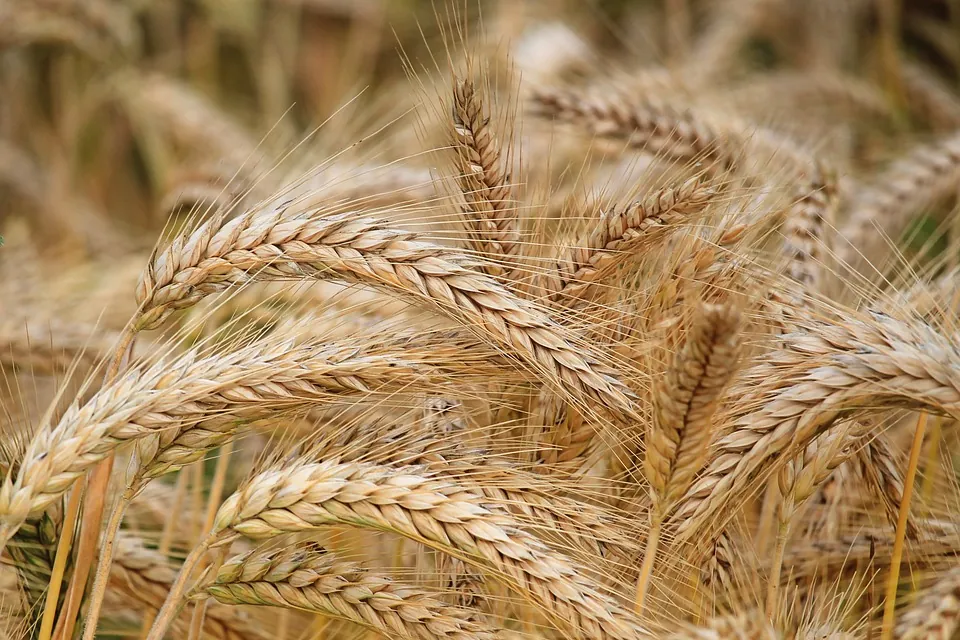
Barley, a member of the grass family, is a major cereal grain grown in temperate climates all over the world. Found in ancient Eurasia civilizations as long ago as 5,000 years, it’s considered one of the first cultivated grains.
A major whole-grain cereal grain, you’ll find barley in bread, beverages and various cuisines of just about every culture. And as we’ve been learning lately, whole grains are an important source of dietary fiber, vitamins, and minerals that are not found in refined or “enriched” grains. Refining grains removes the bran, germ and most of their fiber and nutrients.
So, though Arizona’s barley acres are down this year, it’s still important to know that our farmers are growing this important cereal grain right here in our desert state. Sourced from information by USDA, the University of Arizona and gobarley.com, the following fun facts about barley will make us appreciate this often-overlooked cereal grain.
- The Egyptians were the first known brewers of barley into beer.
- Roman gladiators were called “barley men” (the hordearii) because they ate massive amounts of barley bread since it was believed to increase stamina and strength.
- Malting barley is a delicate process and required close attention to detail and careful timing of even the harvest. The barley must be malted in a living state with a minimum of 95% germination to be suitable for brewing beer.
- Non-alcoholic drinks such as barley water and barley tea (call mugicha in Japan), have been made by boiling barley in water. Barleywine was an alcoholic drink made in the 1700s, prepared from recipes of ancient Greek origin. It was prepared by boiling barley in water, the water from the barley was then mixed with white wine, and other ingredients like borage, lemon, and sugar were added.
- Until the 1500s, barley was Europe’s most important crop, at times even serving as a currency and a standard of measurement.
- About half of the United States’ barley production is used as an animal feed. Barley is an important feed grain in many areas of the world not typically suited for maize production, especially in northern climates.
- Barley is the principal feed grain in Canada, Europe, and the northern United States.
- Barley contains all eight essential amino acids. According to a recent study, eating whole grain barley can regulate blood sugar for up to 10 hours after consumption compared to white or even whole-grain wheat, which has a similar glycemic index. Barley can also be used as a coffee substitute.
- In Arizona, barley is grown mainly as a source of animal feed and used in making beer. Yuma, Arizona-grown barley is a reasonably fast growing and early maturing grain crop, averaging about 50 days from seed to harvest.
To learn more about Arizona’s amazing array of crops grown, go to Fill Your Plate’s blog. Besides articles about nutrition, we periodically highlight the crops this desert state grows.
Calcium and Your Colon: How Calcium Just Might Save Your Life
By Emily Carver, Recent ASU Nutrition Student
When thinking about calcium, the first thought that generally comes to mind is milk and bones.
Growing up, we’re told calcium has a great and positive impact on our bones, and this is true. When children, up through their teen years, consuming the proper amount of calcium, their bones will become strong, which can help keep them from randomly breaking. Most, if not all, people want strong, healthy bones that won’t fail them when they take a step off the curb.
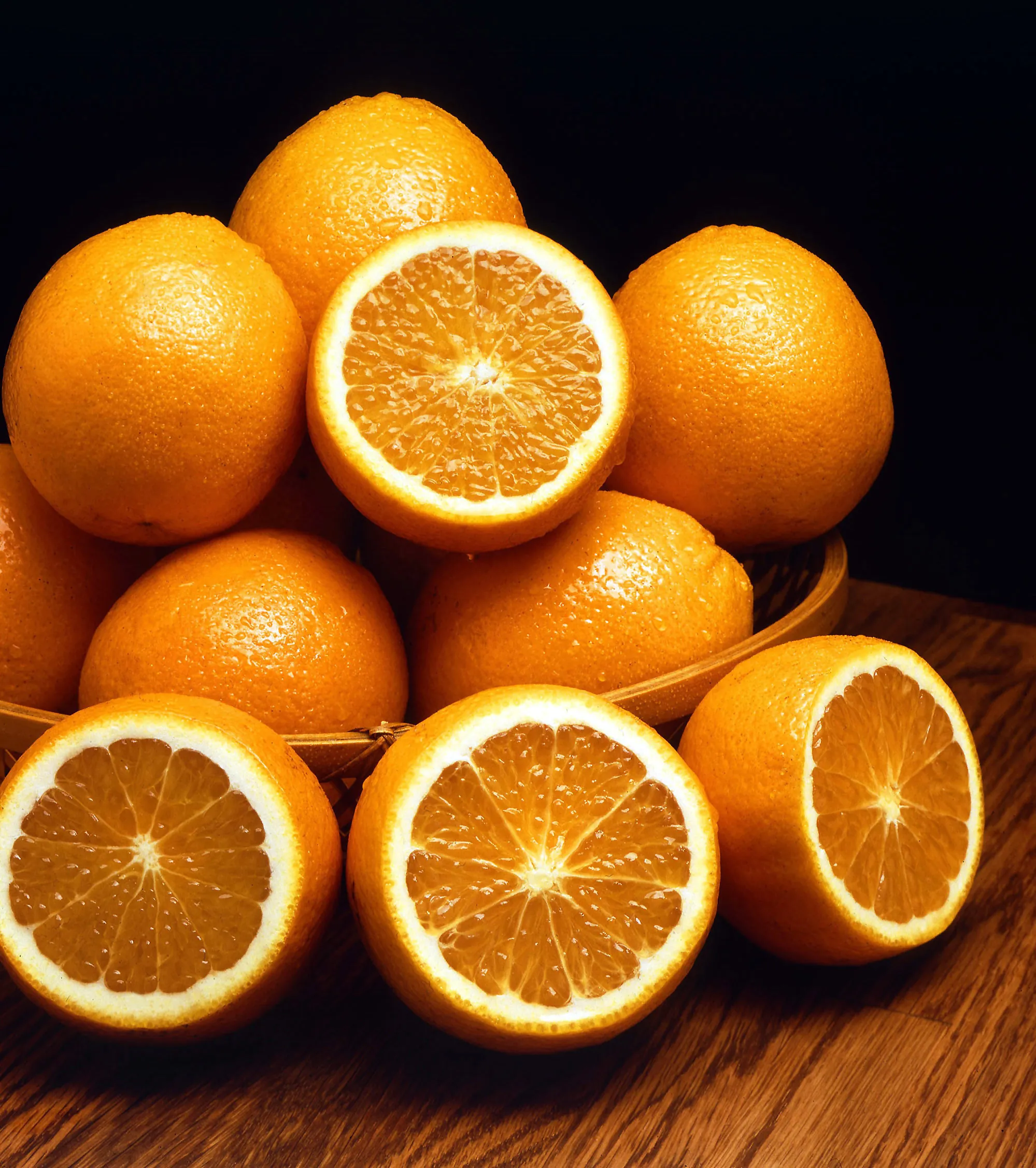
What some might not realize about calcium is it can also have a great and positive impact on the colon. The topic of colon health isn’t exactly a topic to discuss around the dinner table like bones might be, however, it’s a discussion worth having. Colon cancer appears to be on the rise among young adults, and the question as to why is still being asked. It’s worth noting that colon cancer diagnoses in the United States has decreased, yet is steadily increasing among adults between the ages of 20-39.
Perhaps it’s the packaged, preprocessed foods being consumed. Or, certain types of products being used; one cannot know for certain, but regardless of what one may have done in the past, changes can be made now, for a more promising future for your colon.
Consume more calcium. The daily recommended intake of calcium for adults 19-50 years old, is 1,000mg. How much is 1,000mg exactly? It’s drinking just under a quart of 2% milk each day. Quite a lot of milk. If drinking that much milk a day leaves a sour taste in your mouth, then consider the following options as great calcium-rich alternatives.
- 2 ½ Tbsp. grated cheddar cheese – (307mg)
- 8oz plain yogurt, low fat – (415mg)
- 1 cup white beans – (191mg)
- 2 cups cooked kale – (188mg)
- 1 orange – (65mg)
- 1 cup raw broccoli – (62mg)
- 1 cup cottage cheese – (138mg)
- 2 ½ Tbsp. mozzarella, part skim – (333mg)
It’s easy to see just how simple it is to get the necessary amount of calcium through a variety of nutritious sources. By consuming any number of these common foods each day, you’ll not only get the calcium you need, but also a variety of important vitamins and minerals your body needs to remain healthy and strong. With studies showing that consuming the proper amount of calcium can reduce the risk of colon cancer, it’s easy to want to get on board the calcium-consuming train.
Cancer is a scary thing, and colon cancer is no exception. With it being the third most common cancer in the United States and the second leading cause of cancer-related deaths, it’s one to
take very seriously. If you have a family history of colon cancer or feel like the common symptoms the Mayo Clinic list of: blood in your stool, a change in your bowel habits that lasts longer than four weeks, or constant stomach discomfort, like cramps and pain might be symptoms you’re currently dealing with, contacting your doctor to discuss the possibility for a colonoscopy might be worth it.
Four additional ways to reduce your risk. Beyond calcium, some additional ways you can help reduce your risk are maintaining a healthy weight and by exercising on a regular basis. Avoid smoking at all costs. Get regular screenings, and finally consume foods high in fiber, such as leafy green vegetables and a variety of fruits. Colon cancer is one of the more preventable cancers when you take charge of your health, get regular screenings, and eat a well-balanced diet that’s full of the nutrients your body needs.
So, let’s stop that colon cancer number from rising. Grab that orange, eat your broccoli, walk up that flight of stairs, and let’s make our colons happy once and for all.
In a World Full of Kale, Why Not be a Green Bean?
By Sarah LeVesque, Recent ASU Nutrition Student
I’m a lover of all things kale, but lately, I’ve been thinking about green beans: where have they been? Why aren’t they as popular? Why is there a kale craze but no green bean fad? What does kale have that green beans don’t?
Green beans are traced back to Peru. Migrating Indian tribes carried them throughout South and Central Americas. “Common beans,” or green beans made their way to Europe with the likes of Spanish explorers who traveled home. Green beans had a debut in the 19th century with their first appearance in French cuisines. Today we can find them at the Thanksgiving Dinner table in a delicious green bean casserole, in the grocery store fresh or frozen, and sometimes in restaurants as sides. The Journal of Agricultural and Food Chemistry found that green beans have anti-inflammatory properties and are excellent sources of antioxidants. Why aren’t we eating more of them?
For over 2,000 years, wild cabbage’s cousin, the kale, has been cultivated in the Mediterranean region. It’s popular because it grows in the winter. Because it’s a wintergreen, it was seen in crops in Scotland and grows well in cold climates. Kale has been used as a garnish for years before it earned a spot as the main green in salads. “Borecole,” or also known as kale, is used today in smoothies, salads, made into chips, and are found in abundance and in variety in grocery stores everywhere. They’ve been featured in newspaper articles, blogs, and websites. People in the fitness world, food lovers, chefs, and celebrities swear by this magical green as their go to, but why?

A Matchup: Kale vs. Green Beans
The daily recommended intake for healthy adults is about 2 ½-3 cups of leafy vegetables a day. It’s not easy to do so in the fast-paced world we live in. Being busy, we always look for the easiest way to get our calories or nutrients in. While we are making the shift to a healthier, nutrient dense options, it can be a real challenge to get those servings in every single day. So, eating more nutrient-dense items will surely help reach our recommended intakes of foods.
Nutritionally, both green beans and kale are nutrient-dense options that are easy to handle in the kitchen and aren’t too expensive anymore. Fresh, cooked, without any salt or fat added, green beans come in at a total of 44 calories for a cup while kale under the same restrictions is at 36 calories. But comparing the two greens side by side, we can see why kale has been so popular lately.
Kale has been known to be packed with cancer-fighting antioxidants. Kale contains more vitamin A, B6, C, E, and K than green beans at fewer calories making kale a competitive nutrient-dense option. Vitamin A is involved in immune function, reproduction, cellular communication, and vision. With kale containing 126% of our recommended daily allowance of vitamin A, it contributes considerable amounts of critical nutrition for our heart, lungs, kidneys, and other organs. It’s also a reliable source of calcium and potassium. Not only is kale nutritious, it’s a flavorful option available in different varieties.
Green beans are also associated with the health-promoting carotenoid pigments, which is surprising since red and yellow vegetables are best known for this. The American Journal of Applied Sciences in February 2009 found beta-carotene, lutein, violaxanthin, and neoxanthin, the carotenoids, present in green beans. Green beans boast a hybrid of benefits from both legumes and vegetables. Like legumes, they’re useful sources of dietary protein and dietary fiber. Like vegetables, green beans are one of the top vegetables for vitamin C and K. If we really think about it, it is a bunch of little beans wrapped in a leaf! Green beans have also been linked to reducing the risk for chronic diseases like type 2 diabetes, high blood pressure, coronary heart disease and metabolic syndrome.
When it comes down to kale or green beans, you can’t really go wrong. If we are having a variety of vegetables in our diet in sufficient amounts, we can reap the benefits that greens offer. We can see why kale has been so popular: its nutrient dense for the number of calories that it possesses. While kale is high in certain vitamins, green beans serve as a compliment to those vitamins with vitamins that kale lacks: folate, thiamin, riboflavin, and choline.
Since they do well in complimenting each other, why not combine the two! The next time you find yourself in the grocery store wondering what to add to your salads or what you’ll bring to Friends-giving this year, try the recipe below to get more bang for your calories! It was a hit at my family’s Thanksgiving Dinner a few years ago. It a recipe from my father who just had some extra kale lying around and thought to add it to his famous green bean casserole.
| Kale | Green Beans | For the win | |||
| Nutrient | Amount | % of daily target or limit | Amount | % of daily target or limit | |
| Calories | 36 | 44 | KALE fewest calories | ||
| Protein | 2g | 5% | 2g | 5% | |
| Carbohydrate | 7g | 6% | 10g | 8% | KALE lower carbs |
| Dietary Fiber | 3g | 10% | 4g | 16% | GREENBEANS higher fiber |
| Total Sugars | 2g | 2g | |||
| Total Fat | 1g | 0g | GREENBEANS have no fat but KALE contain a small amount | ||
| Calcium | 94 mg | 9% | 55 mg | 6% | KALE higher in calcium |
| Potassium | 294 mg | 6% | 181 mg | 4% | KALE higher in potassium |
| Sodium | 30mg | 1% limit | 1 mg | 0% | GREENBEANS lower in sodium |
| Copper | 202 µg | 22% | 71 µg | 8% | KALE higher in copper |
| Iron | 1 mg | 7% | 1 mg | 5% | |
| Magnesium | 23 mg | 8% | 23 mg | 7% | |
| Phosphorus | 36 mg | 5% | 36 mg | 5% | |
| Vitamin A | 879 µg RAE | 126% | 44 µg RAE | 6% | KALE higher in Vitamin A |
| Vitamin b6 | .2 mg | 14% | .1 mg | 5% | KALE contains more B6 |
| Vitamin C | 53 mg | 71% | 12 mg | 16% | KALE contains more Vitamin C |
| Vitamin E | 1 mg AT | 7% | 1 mg AT | 4% | KALE higher Vitamin E content |
| Vitamin K | 1054 µg | 1171% | 20 µg | 22% | KALE is packed with Vitamin K |
| Folate | 17µg DFE | 4% | 41 µg DFE | 10% | GREENBEANS more folate |
| Thiamin | .1 mg | 6% | .1 mg | 8% | GREENBEANS more thiamin |
| Riboflavin | .1 mg | 8% | .1 mg | 11% | GREENBEANS more riboflavin |
| Niacin | 1 mg | 5% | 1 mg | 5% | |
| Choline | 1 mg | 0% | 21 mg | 5% | GREENBEANS higher in choline |
Kale and Green Bean Casserole
One of the dishes my dad made circa 2013 for Thanksgiving that shocked the entire family! My dad’s always been a can-of-cream-of-mushroom-soup kind of guy, so when we saw him slicing and sautéing, we all sort of gathered around to see what he was creating.
You’ll need:
A basket of mushrooms, sliced
2 cloves of garlic, minced
2 tablespoons of butter or oil
2 bunches of kale, chopped and sliced into medium sized pieces
3 cups of green beans, cooked and cut into 1-inch pieces (my dad loved blanching the green beans)
¼ cup of flour
1 cup of chicken/vegetable broth
1 cup of milk
1 cup of gruyere
2/3 cup of fried onions
Salt and pepper to taste
- Preheat oven to 350F.
- Sauté the garlic and mushrooms in butter in a large pan for about 4 minutes.
- Add the chopped kale and sauté for about 4 minutes or until wilted.
- Stir in the broth, milk, salt, pepper, and flour with a whisk. Bring to a boil and remove from heat.
- In an oven-safe pan, add the green beans. Then carefully pour the mixture into the oven-safe pan, mixing the green beans, kale, and mushrooms.
- Mix in half a cup of gruyere, and sprinkle the rest on top with the fried onions.
- Put into the oven for about 10-15 minutes, or until golden brown and crispy.
- Bring to a friend house and enjoy!
Serves about 6-8 people
Kale and Green Bean Salad
Recipe by Paul Kahan
Featured on BonAppetit.com
You’ll need:
¼ cup olive oil
2 tablespoons fresh lemon juice
1 tablespoon of honey
½ teaspoon crushed red pepper flakes
1 large bundle of kale, leaves removed and chopped into strips
Salt and pepper to taste
1 lbs. of green beans, trimmed
¼ cup of parmesan
- Mix oil, lemon juice, honey and red pepper in a large bowl.
- Next, toss kale in and season with salt and pepper to taste. Let the kale marinate for about an hour at room temperature, giving it an occasional toss to coat evenly.
- While the kale is marinating, Blanche the green beans: boiling for two minutes, removing from the water and dropping the green beans into a bowl of ice water.
- Pull out and drain. Dry the green beans and let them coo.
- Once the kale is done marinating, mix together the ingredients, salt and pepper to taste, and sprinkle with grated parmesan and serve.
The oil, lemon juice, honey, and red pepper mixture double as your dressing! You can use other green beans to save some time. Sometimes I use the microwave packages of green beans and cook for ½ the time instructed, letting the bag sit unopened for the other half the time.
15 Meal Planning Guidelines For Your Preschooler
By Alise Robers, Recent ASU Nutrition Student
Getting little ones to try new foods, or eat what you put in front of them can be a challenge. Some children won’t eat things just because they look ‘gross,’ while others put everything in sight (including non-food items) in their mouths. Kids have been known to refuse food because the color is not to their liking, different foods are touching or mixed together, or because it smells weird.

Several nutritionists and food experts suggest a variety of ways to help your kids eat healthily. Make your life a little easier and keep these 15 tips in mind the next time you are planning a meal for your child:
- Offer simply prepared foods. This means avoiding casseroles or any food that is mixed together. Children need to be able to identify what they are eating and some may not want their foods to touch on the plate at all.
- Offering choices is a great way to make them feel a sense of control over what they are eating. Offer 2 or 3 healthy choices to choose from, stay away from junk foods. This is giving the child the sense of the independence they want to have while still keeping you in control of nutrition.
- Children learn new foods by being presented with them over and over again. Put a small amount of a new food along with your meal but don’t require the child to eat it if he/she doesn’t want to. The more times this is done, the more likely they will be to eventually try the food.
- Provide at least one colorful food at every meal (such as carrots or broccoli).
- Avoid strong flavored foods and foods high in salt. These will taste too strong due to the higher amount of taste buds children have compared to adults.
- Let them make their own plate. Provide them with a variety of healthy foods and let him/her decide what and how much they want. Letting them take control of what goes onto their plate lets them exercise independence and they may be more willing to try new healthy foods if they are not being forced into it.
- Try providing one soft or moist food at each meal that is easy to chew. Developing their chewing skills is important, so a crisp or chewy food is important too.
- Don’t make snacking a habit. It’s easy to give them a bag full of pretzels when they say they are hungry but this can lead to bad habits. A random snack runs the risk of encroaching on the next mealtime causing them to not be hungry for the healthy meal you had planned.
- Carbohydrates are always a crowd pleaser because they are easy to hold and chew. Whole grains are the best route to go!
- Lumps are usually a no-go. Try a smoothly textured food such as soup or mashed potatoes.
- Include your child in the cooking process. If they get a sneak peek to the behind the scenes of dinnertime then they are more likely to try a new food. While you’re letting them help you is a great opportunity to talk about the nutritional value of the food your making.
- Be aware of the temperature of the food you’re serving. Children’s mouths are very sensitive to hot and cold. Try warm food, not hot.
- Planned, healthy snacks are important. Cutting up fruits and vegetables is a good and nutritious way to go. For added flavor let them spread on some peanut or almond butter. Or let them use a spoon to eat yogurt.
- Make sure your child is getting the nutrients they need. Children are most likely to be lacking in fiber, vitamin D, iron, and calcium.1
- Lead by example. Children pay a lot more attention to what you’re doing than you may realize. Keep in mind that your approach to healthy foods can influence your child’s attitude towards them!
For more fun and informative article check out the Fill Your Plate blog. New articles are posted every Monday, Wednesday, and Friday.
References:
- Brooks, Ashley. “Rasmussen College.” Rasmussen College- Regionally Accredited College and on Campus. N.p., n.d. Web. 2017. http://www.rasmussen.edu/degrees/education/blog/how-to-get-kids-to-eat-healthy/
- Drummond, Karen E, and Lisa M. Brefere. Nutrition for Foodservice and Culinary Professionals. 8th Hoboken, NJ: John Wiley & Sons, Inc., 2010. 388-389. Print.
- “Strategies for Feeding a Preschooler.” Ed. Mary L. Gavin. The Nemours Foundation, Nov. 2014. Web. 2017. http://kidshealth.org/en/parents/feed-preschooler.html
Fill Your Plate with Cabbage
By Sarah Levesque, Recent ASU Nutrition Student
We grow lots of cabbage and bok choy in Arizona during the winter. Here’s why it’s so healthy.
A staple in kimchi, and is used for soups or for the outer rolls for pork, chicken and seafood dishes, Chinese cabbage is a green leafy vegetable that is high in fiber, vitamins, and minerals. But Chinese cabbage is more than just a side at a Korean dinner, it’s a nutrient-dense vegetable that has many health benefits. Chinese cabbage has been studied for its ability to reduce inflammation and atherosclerosis.

Adding bok choy, another name for the Chinese cabbage, to your plate at home does more than add variety of nutrients, it also has a mild flavor. Although this leafy vegetable has been around for years, its health benefits and cancer-fighting properties are still being discovered today.
If the bold flavor and crispy texture aren’t enough to convince you to add it to your weekly menu, here’s a list of what bok choy has to offer otherwise. Competing against kale, bok choy is a nutrient-dense option to add a variety to your kitchen to help you mix it up and take a chance on a less popular green that deserves some attention.
Bok Choy contains:
Glutamine
It’s the same family of broccoli, Brussels sprouts, cauliflower, and kale. These are cruciferous vegetables that are rich in nutrients, minerals, and carotenoids. Cabbage is high in glutamine when it’s uncooked. Glutamine is the most common amino acid found in your muscles. Even though your body can make enough of this amino acid, after an intense workout or injury, your body might need more than it can produce. Instead of taking glutamine supplements after tough workouts, incorporating green leafy vegetables like Bok Choy is a healthier option that could save you money.
Vitamin A-RDA 2300 IU for Women, 3000 IU for men
Bok Choy is also high in vitamin A. Vitamin A helps with our vision in dim lighting and lower the risk of cataract and macular degeneration. It also helps keep our skin healthy and supports our body’s natural ability to fight against illness and infection. Just 100 g of fresh bok-choy is 149% of our daily-required amounts of vitamin A coming in with a whopping 4468 IU of vitamin A in just 100 g of uncooked bok choy.
Vitamin C- RDA 60 mg
Just 100 g of bok choy provides us with 75% of our daily requirements of vitamin-C, which supports our immune systems. This makes bok choy a great option to add to soups or broths when trying to fight off that cold since it acts as a shield against free radicals.
Vitamin K- RDA 122 µg-138 µg
This vitamin is being studied today for its potential role in strengthening our bones and delaying osteoporosis. Vitamin K is also known for its role in blood clotting and regulation of blood calcium. We can get 38% of our recommended daily allowance of Vitamin K in just 3.5 ounces or 100 g of uncooked bok choy.
Calcium– RDA 1000 mg
Bok choy offers a variety of minerals. It contains approximately 11% of our daily recommended allowance of calcium. Calcium helps keep our bones strong and control muscle and nerve function.
Magnesium- RDA 310-420 mg
Magnesium helps regulate reactions in the body from protein synthesis, muscle and nerve function, blood glucose control, and blood pressure regulation. It’s also important for muscle contraction, regulating your heart rhythm, and nerve impulse conduction. Just 100 g of bok choy serves up 5% of the recommended daily allowance.
Iron- RDA 11/15 mg
10% of our recommended daily allowance of iron can be obtained from just 100 g of bok choy. Women actually require a little more iron in their diet than men because of menstruation. Iron supports a healthy metabolism, is necessary for growth, development, cellular function, and synthesis of hormones and connective tissue.
Potassium- RDA 4700-5100 mg
For healthy muscle and nerve function, potassium is an important mineral. Potassium helps regulate fluid and electrolyte balance, heart function, nerve impulses, and contraction of skeletal and smooth muscle. With about half of what a banana offers, bok choy offers 5% of our RDA.
There’s a lot of studies being done on bok choy, and similar dark, leafy greens, to understand the full potential eating Chinese cabbage has on our health. Bok choy is inexpensive and is found in most stores next to the other greens.
Instead of cooking the cabbage, I decided to try it as a salad to preserve the flavor and the nutrients that the greens offer. As someone who eats mostly spinach and arugula, I loved having this green in place of the usual. It was an enjoyable way to mix things up a bit. It had a very robust and full flavor that paired well with the aromatic red bell pepper I added to the dish. The cucumbers tied together the bell peppers and bok choy well. I dressed it with just balsamic vinegar, salt and pepper, and olive oil.
The Fill Your Plate website has many amazing recipes, some of the recipes call for bok choy! Be sure to take a look at the recipes and other articles on the Fill Your Plate Blog!
Quality Carbohydrates
By Alise Robers, Recent ASU Nutrition Student
The most important thing about carbohydrates is the type you choose to eat. Carbohydrates include sugars, starches, and fibers that work as the body’s main source of energy. We are probably most familiar with them in their refined forms, which include table sugar and high fructose corn syrup used in cookies, soft drinks, candies, jams, and other sweetened foods.
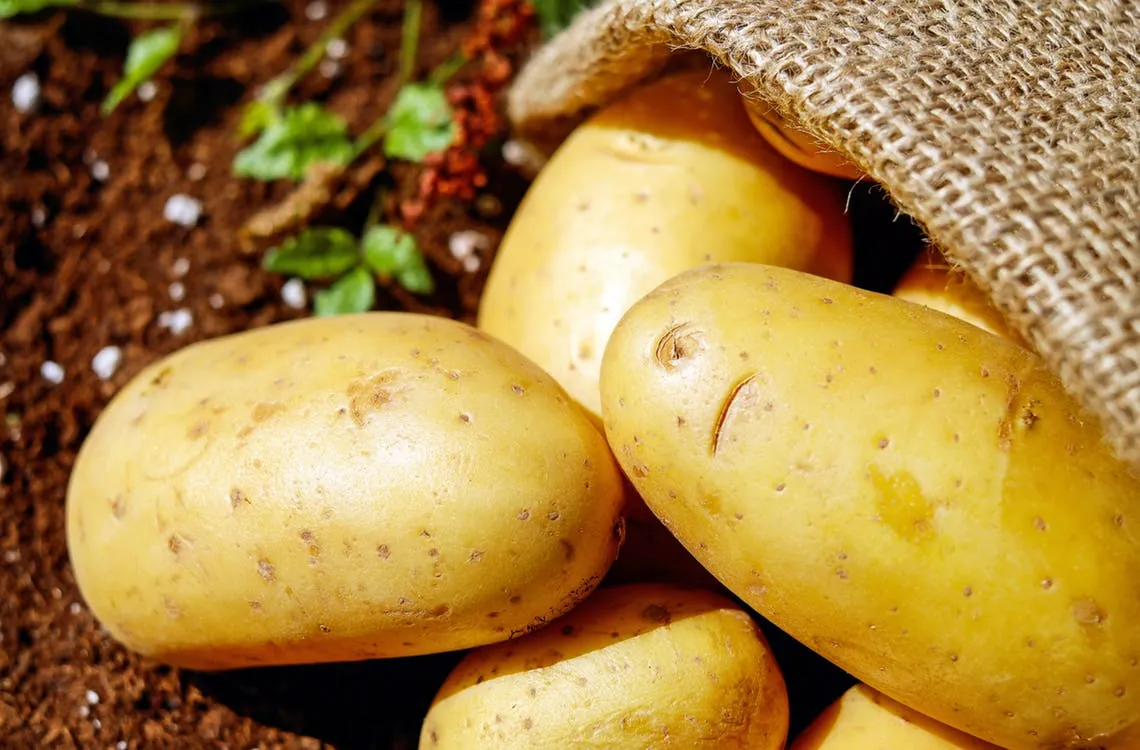
Keep in mind that some sources are healthier than others. Good sources of carbohydrates include legumes (dried beans and peas), vegetables, fruits, nuts, seeds, and whole grain foods. For example, switch out the french fries or highly refined white bread you were going to have for dinner with some whole wheat bread or quinoa!
Listed below are eight quality carbohydrate options to mix into your diet.
Brown Rice
Steamed brown rice is a great carbohydrate option. The difference between white and brown rice is how they’ve been processed.1 Before white rice went through any kind of refining process it looked exactly like brown rice. Once the rice is refined it is stripped of the side hull and bran, which contains protein, thiamine, calcium, magnesium, fiber, and potassium.2 This process also changes how our bodies use the carbohydrates. Food is our body’s source of energy and brown rice burns much slower than white rice, meaning you will have more energy for a longer period of time after eating brown rice.1 knowing this, adding a serving of brown rice combined with a portion of protein and vegetables is a quality meal. But, rice in general is better than none. So, even white rice has its merits.
Potato
Potatoes make it easy because nature has made them the perfect size; just pick one that is about the size of your clenched fist and you’re good to go.1 No measuring or weighing necessary. They are good to pair with any protein and taste great even without adding all the butter or sour cream. However, if you need that extra flavor then try it with a spoonful of salsa, ketchup, or a pinch of salt and pepper!
Oatmeal
Oatmeal is a delicious breakfast option that is easy to make, inexpensive, and packed full of nutrients. Something to watch out for when picking your oatmeal is the large amount of sugar hidden in instant oatmeal products.1 Avoid these and grab yourself some old-fashioned Quaker Oats and top them with berries, cinnamon, and honey for some added texture and flavor!
Whole-grain Pasta
Pasta is a good low-fat source of carbohydrates as long as you can recognize the difference between a plateful and a portion! Opting for whole grain pasta is an even healthier option because it contains the same amount protein, has more fiber, and fewer calories.3 Instead of topping your pasta with a heavy sauce, butter, or cheese try adding a good source of protein (shrimp or chicken) and squeezing some lemon on top. Now you have a delicious and simple meal.
Sweet Potatoes and Yams
Contrary to popular belief, many people assume that sweet potatoes are higher in calories than a regular potato because they are so much sweeter. This is not the case. Both are actually very similar when it comes to calories.1 It is best to store sweet potatoes in a cool dry place and not in the refrigerator. Putting them in the refrigerator will cause them to become hard and bitter tasting.1 the best way to prepare these carbohydrates is by baking, boiling, or microwaving them.4 If you want to spice up your sweet potato try adding a sprinkle of cinnamon and a dab of butter.
Greek Yogurt
Yogurt is not only a good source of protein but also of carbohydrates. It is also loaded with probiotics that can help maintain the balance of bacteria necessary for a healthy digestive system and boost your immune system.1, 5 Sadly, I’m not talking about frozen yogurt because it is too high in sugar. Greek yogurt, however, is a great snack that can be topped with fresh fruit or granola.
Fruit
Fruit is a deliciously sweet carbohydrate that nature has also already portioned for us! 1 Grab an apple, a banana, or a peach and you’re good to go. They’re packed with nutrients and are easy to throw in your bag for a snack on a busy day. You can also combine them with a source of good protein and you have yourself a healthy meal. One example, enjoy a hard-boiled egg and a grapefruit.
Whole-Wheat Bread
Whole wheat bread is great as long as you make sure you are buying breads that list whole grain, whole oats, whole rye, whole grain corn, whole grain barley, or brown rice as the first ingredient.7 Stay away from breads that list wheat flour, degerminated cornmeal, or enriched flour as their first ingredient because these are not good sources of whole grain.7 A serving size is generally one slice of bread or one whole-wheat tortilla.1,6 To make this a wholesome meal add some protein (chicken or turkey) and veggies for a hearty but healthy sandwich or wrap!
References:
- Phillips, Bill, and Michael D’Orso. “The Nutrition for Life Method.” Body For Life. 1st New York: HarperCollins, 1999. 86-89. Print.
- “10 Reasons Why Brwon Rice is the Healthy Choice.” VegKitchen. N.p., 09 Apr. 2017. Web. 2017
- Writer, Leaf Group. “Whole-Grain Pasta vs. Regular Pasta.” Healthy Eating | SF Gate. SF Gate, 05 July 2012. Web. 2017
- “Whats New and Beneficial About Sweet Potatoes.” The Worlds Healthiest Foods.p., n.d. Web. 2017. http://whfoods.org/genpage.php?dbid=64&tname=foodspice.
- “Yogurt Nutrition- Nutrients Contained in Yogurt, Health Benefits, Greek Yogurt.” org. Dairy Council of California, 2017. Web. 2017. http://www.healthyeating.org/Milk-Dairy/Nutrients-in-Milk-Cheese-Yogurt/Yogurt-Nutrition.aspx
- “U.S. Dietary Guidelines and WG.” S. Dietary Guideline and WG | The Whole Grains Council. Whole Grains Council, n.d. Web. 2017.
- Drummond, Karen E., and Lisa M. Brefere. “Chapter 3, Carbohydrates.” Nutrition for Foodservice and Culinary Professionals. 8th New Jersey: John Wiley & Sons, Inc., n.d. 92-93. Print.

